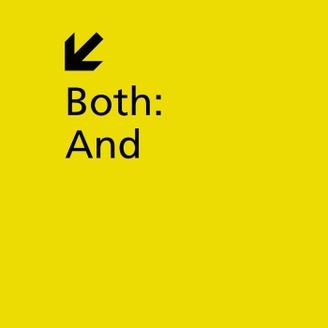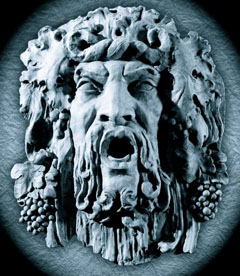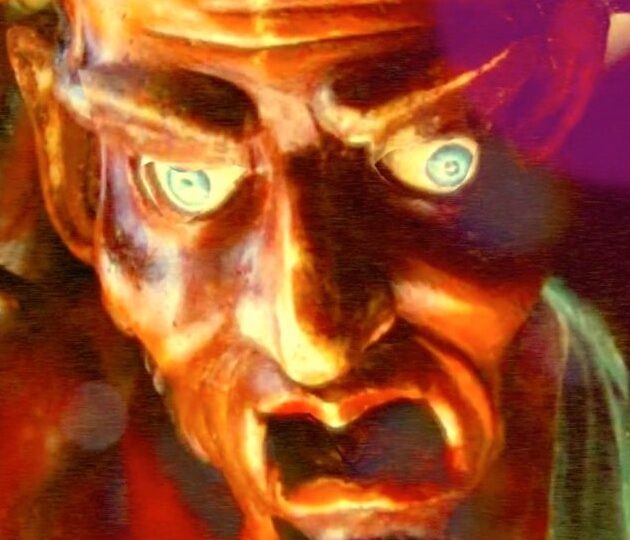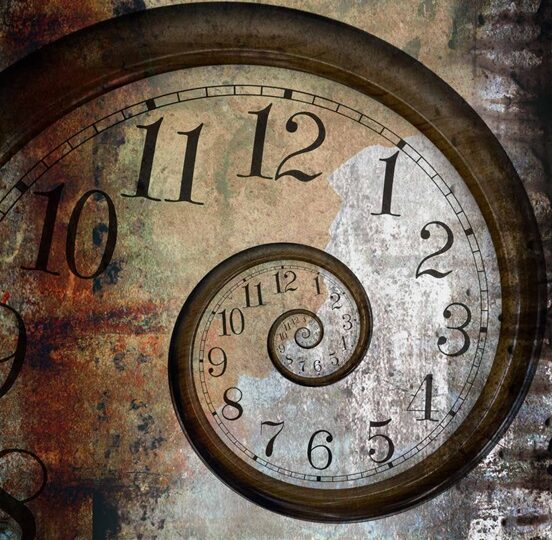
And the Design of Experience
There is no creation ex nihilo. We always work from pre-existing material, both literal substances (wood, a language, the resonance of strings and reeds) and the existing cultural organization of those materials within history, tradition, and contemporary networks of influence. So as we survey the expanding and converging landscape of electronic, virtual, and immersive production, we might ask ourselves: what material is being worked here? Is it simply new organizations of photons, sound waves, and haptic cues? Or does the “holistic” fusion of different media and the construction of more immersive technologies actually suggest another, perhaps more fundamental material?
I’d wager that the new material is indeed rather fundamental: human experience itself. Of course, “human experience” is a vague and historically loaded concept, and a thorough hashing out of the term would require, at the very least, lengthy excursions into Jamesian pragmatism, psychobiology, and Buddhist phenomenology. But for the moment let’s just think of human experience as the phenomenal unfolding of awareness in real time, a movement which tugs against the network of concepts and significations while tending toward the condition of more direct sensation or intuitive perception. In other words, experience may not be able to escape the prisonhouse of language, but it willingly sticks its nose out the barred window and inhales.
Many semiotic and structuralist arguments suggest that we are creatures of language, that nothing, either sensations or intuitions, escapes the domain of signs. But one can just as easily argue that everything that arises in consciousness is experience that memory, analysis, and reflection all arise in the phenomenal stream, the loops and twists, of James “stream of consciousness.” As a compromise between these two positions, imagine that you possess an analog Consciousness slider that runs from the nearly totally linguistic on one side to the pure intensities of sensation on the other. While avoiding a strict divide, your thought gizmo allows you to make a gradual though clear distinction between meaning and sensation.
Take the example of a rollercoaster. Obviously roller-coasters exist within a network of symbolic associations. But the act of subjectively submitting your bodymind to a rollercoaster ride, and undergoing the resulting thrills of adrenaline, fear, and gut-fluttering sensation, cannot be directly assimilated to the network of significations that constitute the meaning of rollercoasters. The same point can be made about recreational drugs. Obviously the drug experience is mediated by culture, by expectations, rituals, and social stories about the meaning and value of certain compounds. But we are sticking our heads in the sand if we insist that the evident physiological changes induced by drugs do not correspond with real psychological changes, not only in the content of subjective experience (its images, pleasure fluxes and meanings), but in the more fundamental cognitive parameters which structure experience in the first place.
At the same time, these non-semiotic elements of experience can also function as passageways to new regimes of signs. Fans of psychedelics often find themselves plunging into incoherent or abstract deformations of perception and sensation, only to “break through” into very strange, but nonetheless solid and coherent, worlds of meaning. Immersive works of art or entertainment are also rarely content to simply produce a new range of sensations. Instead, they often function as portals into “other worlds.” Following a similar development, the rollercoaster grows into themed adventure rides like Universal Studios Back to the Future attraction. These other worlds, of course, are composed of the same sorts of signs that make up our shared human construct indeed, they often detach those signs from conventional reality, recombining or morphing them within the more malleable zone of the virtual. But in order to successfully boot up these new semiotic universes within a users consciousness, the media technology must directly engage the machinery of human perception (proprioception, 3d audio, etc) on a “subliminal” level. In other words, immersive worlds are constructed on a platform of rejiggered experience.
And so we enter the era of what Im calling Experience Design. A quick scan of our sociocultural landscape suggests that, in terms of artistic practices, mass entertainment, sports, and emerging technologies of pleasure, productive forces are increasingly targeting experience itself that evanescent flux of sensation and perception that is, in some sense, all we have and all we are.
Lets begin with the rise of the so-called “experience economy.” On one level, this describes an apparent shift within the consumption patters of the younger, more technologically savvy elite, a shift away from the hoarding of material goods and status symbols to the hoarding of novel, exciting, and challenging experiences. (Dennis Titos 20 million-dollar space holiday on MIR is the paragon here). The experience economy of the super-rich also dovetails with broader cultural trends, including the dramatic intensification of tourism over the last few decades a process which offers us increasingly specialized, adventurous, and exotic packages (guzzling ayahuasca with Peruvian shamans, caving in Belize, visiting real live monks in Bhutan). We have also seen a heightened interest in technologically-mediated outdoor activities like rock climbing or wind surfing, along with the rise of “extreme sports,” which have little to do with sports as contest and much to do with the production of subjective intensity. The extreme example here is the Bungie jump, which requires neither skill nor exertion beyond the passive willingness to undergo the death-defying neurotransmitter and adrenaline rush that hits the nervous system.
The turn towards increasingly raw experience also marks a number of developments within media and entertainment, including the often-remarked descent to the lowest common denominator of sex, violence and the gross-out stunts of MTVs Jackass (“Don’t try this at home!”). Over the last ten or fifteen years we have also seen the rise of a new kind of film, one which features amazing special effects, but which otherwise sucks. Whether or not we judge such films to be good, or even worthwhile, depends on how much we accept the new regime of special effects as a semi-autonomous component of cinema whose art is largely devoted to stimulating immediate sensations and visceral rather than symbolic or narrative emotion. A similar logic comes to the fore in many computer games and mass applications of virtual reality technologies in amusement parks and arcades, all of which strive for the quality of “immersion” which is often just another word for simulated experience. Meanwhile, the language of “experience” has become thoroughly integrated into multimedia design, even in the relatively low-bandwidth tricks and offerings that commercial websites use to capture sticky eyeballs.
***
In the musical sphere, we can see a similar shift in the rise of raves, where intense lights, sounds, and projection screens combine to create a visceral, often collective experience of intensity and atmosphere. These effects (and affects) differ markedly from the more traditional identifications available through even the most Dionysian rock concerts. Another crucial ingredient to the rave experience is drugs. As Simon Reynolds has argued, many elements of electronic dance music, including non-sonic elements like light sticks and Vicks Vap-o-rub inhalers, emerged because of the particular effects they produce in a suitably tweaked mind. In fact, psychoactive drugs are in some ways the ultimate “technology of experience,” and establish a basic model for Experience Design. The rapid advances in psycho-pharmacology, both corporate and underground, have given rise to a flood of consciousness-modifying substances which promise to both suppress unwanted dimensions of human experience (depression, anxiety) and open up novel spaces of perceptual and cognitive effects to immediate exploration.
Obviously, a startlingly broad range of phenomena can be placed under the umbrella of Experience Design, and such breadth is often suspicious. But despite a number of crucial problems that are overlooked in this acute generalization, it seems crucial to recognize and emphasize the continuity, rather than the divergence, between contemporary practices that target the human sensorium. Across the fields of art, architecture, media, music, pharmacology, even spirituality, we are moving towards the intentional and multi-dimensional stimulation and production of a complex range of increasingly immediate human responses, including the direct induction of classic “altered states of consciousness.” These responses extend far beyond (and below) the traditional object of communication: the conscious human subject conceived as a rational agent and a reader of meanings. In other words, as science, pharmacology, and media technology deepen their understanding of how the human nervous system joins with the ever mercurial psyche to produce a lived sense of reality, these knowledges are becoming integrated into the engines of cultural production. To put it crudely, our cultural technologies are becoming less like books and songs, and more like rollercoasters or drugs.
Media art, with its connections to both alternative culture and critical theory, is curiously arrayed when it comes to Experience Design. On the one hand, its theoretical savvy frees it from the traditional notion of the subject as an autonomous agent of meaning, while also increasing the willingness to play with the construction of subjectivity. Yet many artists, writers and theorists remain queasy about the more technoscientific knowledges and practices involved in understanding and producing human subjectivity within the increasingly technical domain of psychology. This reflexively critical response to technoscientific discourses is mirrored in a similarly pervasive set of responses to spiritual or ritual discourses, which also fundamentally engage experience and the production of altered states of consciousness. While artists are becoming more overtly concerned with bioscience and spirituality alike, both of these flinches continue to result in art which stresses critical distance over the direct mobilization of effects and novel zones of becoming. This distance is valuable, but insufficient. However legitimate, skepticism and distrust of hard psychology, neural science, and psychobiology should not cut the (post)humanistic world off from direct engagement with the proliferating technologies of subjectivity.
For one thing, many other sectors of society are perfectly happy to employ these same tools to far more chilling ends. Advertising and marketing are only the most obvious examples on what I would call the right wing of Experience Design. (“Black magic” would perhaps be a more appropriate term, but I will leave the occult dimension of Experience Design aside for now). Here the target is often demonstrably irrational: an instinctive, un-self-aware subject whose inchoate fears and desires are organized around commodities or institutions. Though one must always beware of excessive fears over “subliminal” advertising, mall rats with sensitive noses will also recognize the pine and spice scents pumped into malls around Christmas time. Some slot machines are now equipped with high-tech smell emitters because certain scents have proven to keep individuals at the machines longer. Whether or not these cues are culturally determined is beside the point. Whats important is that at the moment, these stimulants aim for a technical zone of influence below “propaganda,” which is still linked explicitly to a field of meanings. Instead they directly attack the limbic system, drawing the subject into a deeper, more immersive activity. As the West embarks on a Shadow War against terrorism, the tools of propaganda and psychic management alike can only proliferate.
***
By embracing the tools of Experience Design, media artists have and can continue to critique our expanding technosphere while also probing its capacity for beauty, pleasure, and novel perceptions — even wisdom. Artists are uniquely placed to interrogate the production of technological experience, and to question the dominant experiences which are being engineered and renormalized by massive commercial engines of subjectivity. But this critical function must be coupled with experiment, with the willingness to creatively participate in the larger cultural process of re-engineering subjectivity, of pushing the envelope of experience. This is not necessarily a matter of becoming high tech — relatively low-tech artists like Gary Hill and Bill Viola have made great strides in this direction. But it is a matter of directly engaging, not simply the new technologies, but the underlying technical “material” of subjectivity itself.
Finally, I believe this turn towards experience, in art and technology, is related to the growing embrace of the discourses and practices of spirituality. Whether or not it is defined or encountered within the context of faith traditions or not, “spirituality” largely emphasizes the use of subtle “psychological” techniques and practices to open up and transform our existential, personal, subjective encounter with the world and the self. At its best, the global turn towards meditation, yoga, healing prayer, trance dancing, and practices of loving-kindness reflects a search for a higher tone of experience itself, not a hunger for new consoling beliefs. The secular spirituality of self-help books, brain machines, and leadership seminars can also be seen as a species of “Experience Design” in that it emphasizes changing, or reprogramming, your direct experience of your self in the world. However, here the underlying intentions which in some sense make or break spiritual aspiration often leave much to be desired.
Media artists are uniquely placed to explore this emerging world of spirituality without falling into the dogmatic or New Age traps that swallow up so many true believers. Altered states of consciousness are real, and as our media technologies get better at drawing us in and out of them, artists and other non-coercive proponents of the human spirit (or whatever you want to call it) need to become familiar with these states, not simply as a source of inspiration, but as modes of expression, communication, and confrontation itself. By recognizing that the material that we are now focused on is not technology but human experience itself, then we take a step closer to that strange plateau where our inner lives unfold into an almost collective surface of shared sensation and reframed perception a surface on which we may feel exposed and vulnerable, but beginning to awake.




